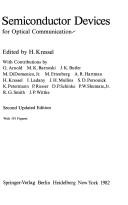| Listing 1 - 3 of 3 |
Sort by
|

ISBN: 9780387096377 9780387096360 3540096361 9783540096368 0387096361 Year: 1980 Volume: 39 Publisher: Berlin: Springer,
Abstract | Keywords | Export | Availability | Bookmark
 Loading...
Loading...Choose an application
- Reference Manager
- EndNote
- RefWorks (Direct export to RefWorks)
It has become increasingly evident in recent years that, apart from the key role that thrombin plays in the blood coagulation cascade, thrombin also elicits cellular actions via the activation of proteinase-activated receptors, which are present in many cell types. These effects of thrombin are seen in a variety of physiological as well as pathological phenomena, including vascular development and physiology, tumor progression and metastasis, neuronal functions, inflammation, angiogenesis. Thrombin: Physiology and Disease, edited by Michael E. Maragoudakis and Nikos E. Tsopanoglou, emphasizes the new developments in this important field of research and provides the basis for translating these findings into therapeutic targets."
Book
ISBN: 9780387098463 9780387098456 Year: 2009 Volume: 11 Publisher: Boston MA Springer US
Abstract | Keywords | Export | Availability | Bookmark
 Loading...
Loading...Choose an application
- Reference Manager
- EndNote
- RefWorks (Direct export to RefWorks)
The evolution of the neural crest sheds light on many of the oldest unanswered questions in developmental biology, including the role of germ layers in early embryogenesis, the development of the nervous system, how the vertebrate head arose developmentally and evolutionarily, and how growth factors and Hox genes direct cell differentiation and embryonic patterning. In this new edition of his essential work, The Neural Crest in Development and Evolution, Brian Hall has provided an up-to-date technically and intellectually rigorous synthesis of knowledge of all aspects of the neural crest and of neural crest cells (NCCs). These ten chapters are organized into three parts: (I) The discovery, and developmental and evolutionary origins of the neural crest; (II) cellular and tissue derivatives of the neural crest; (III) and tumors and birth defects arising from abnormal NCCs. The genetic and cellular bases for the identification of NCCs as early as during gastrulation, for induction of the neural crest, NCC delamination, migration and differentiation understanding of all of which has increased enormously over the past decade are discussed in depth in Part I. The evolutionary origin(s) of the neural crest is examined through an analysis of fossils, and of cell types, genes and gene networks in extant cephalochordates (amphioxus) and in ascidians. Four chapters grouped as Part II examine all aspects of neural crest-derived pigment cells, neurons, skeletal, cardiac and tooth-forming cells, with emphasis on how and when subpopulations of NCCs are specified and how their differentiation is controlled. The two chapters in Part III revisit NCC development in the context of tumors (neurocristopathies) and birth defects, with emphasis on genetic pathways, regulation of cell populations, and whether NCCs can be considered to be stem cells. About the Author: About the Author: Dr. Brian K. Hall has devoted much of his career to the study of the evolution and development of neural crest-derived skeletal tissues. He is a University Research Professor Emeritus at Dalhousie University in Halifax, Canada, a Visiting Distinguished Professor at Arizona State University in Tempe, a Fellow of the Royal Society of Canada, and a foreign fellow of the American Academy of Arts and Sciences.
Human genetics --- Ethnology. Cultural anthropology --- histologie --- Physiology of nerves and sense organs --- Histology. Cytology --- Europees recht --- General embryology. Developmental biology --- neurobiologie --- genetica --- Evolution. Phylogeny --- medische genetica --- cytologie --- embryologie (geneeskunde) --- Compound semiconductors. --- Electron transport. --- Composés semiconducteurs --- Electrons --- Transport --- EPUB-LIV-FT LIVBIOLO LIVBIOMO LIVMEDEC SPRINGER-B
Book
ISBN: 9783642033032 9783642033339 9783642424090 9783642033025 Year: 2010 Publisher: Berlin : Springer-Verlag,
Abstract | Keywords | Export | Availability | Bookmark
 Loading...
Loading...Choose an application
- Reference Manager
- EndNote
- RefWorks (Direct export to RefWorks)
This book presents a detailed description of the basic semiconductor physics. The reader is assumed to have a basic command of mathematics and some elementary knowledge of solid state physics. The text covers a wide range of important phenomena in semiconductors, from the simple to the advanced. The reader can understand three different methods of energy band calculations, empirical pseudo-potential, k.p perturbation and tight-binding methods. The effective mass approximation and electron motion in a periodic potential, Boltzmann transport equation and deformation potentials used for full band Monte Carlo simulation are discussed. Experiments and theoretical analysis of cyclotron resonance are discussed in detail because the results are essential to the understanding of semiconductor physics. Optical and transport properties, magneto-transport, two dimensional electron gas transport (HEMT and MOSFET), and quantum transport are reviewed, explaining optical transition, electron phonon interactions, electron mobility. Recent progress in quantum structures such as two-dimensional electron gas, superlattices, quantum Hall effect, electron confinement and the Landauer formula are included. The Quantum Hall effect is presented with different models. In the second edition, the addition energy and electronic structure of a quantum dot (artificial atom) are explained with the help of Slater determinants. Also the physics of semiconductor Lasers is described in detail including Einstein coefficients, stimulated emission, spontaneous emission, laser gain, double heterostructures, blue Lasers, optical confinement, laser modes, strained quantum wells lasers which will give insight into the physics of various kinds of semiconductor lasers, in addition to the various processes of luminescence.
Quantum mechanics. Quantumfield theory --- Optics. Quantum optics --- Statistical physics --- Electronics and optics of solids --- Solid state physics --- Matter physics --- Materials sciences --- Electronics --- Electrical engineering --- Applied physical engineering --- EMI (electromagnetic interference) --- materiaalkennis --- materie (fysica) --- quantummechanica --- elektronica --- fysica --- elektrotechniek --- micro-elektronica --- transistoren --- halfgeleiders --- microwaves --- Semiconductors --- Semiconducteurs.
| Listing 1 - 3 of 3 |
Sort by
|

 Search
Search Feedback
Feedback About UniCat
About UniCat  Help
Help News
News